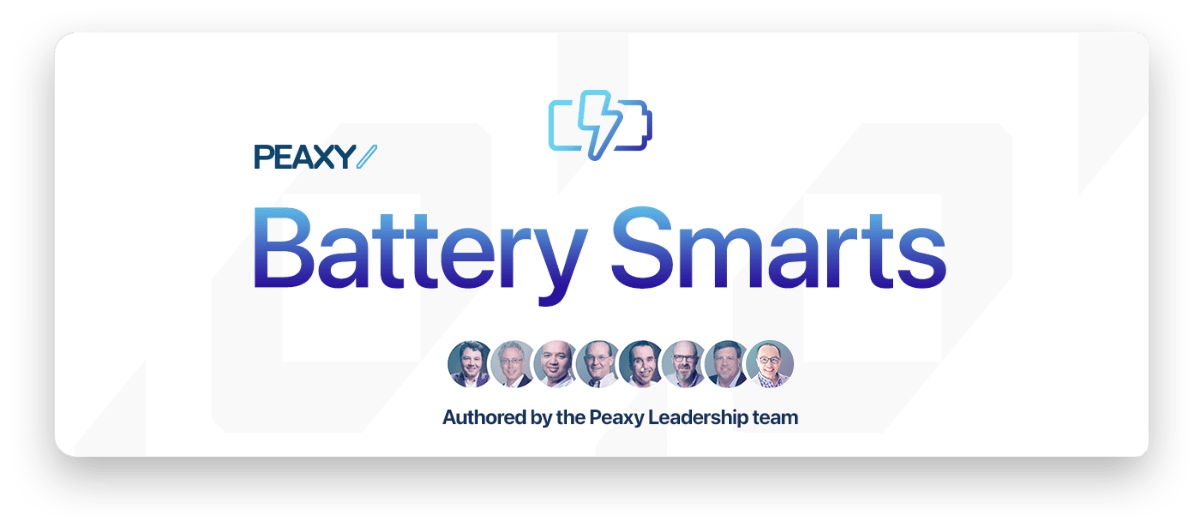The demand for battery energy storage is growing rapidly in the US, as more renewable energy sources are integrated into the grid. The US battery energy storage market added 5,597 megawatt hours (MWh) in the second quarter of 2023, a new quarterly record1. The US Energy Information Administration (EIA) forecasts that battery capacity will rise by 9 GW (104%) in 2023 and by 10 GW (54%) in 20242. California was No. 1 among states with the most grid-scale energy storage installations, with 738 MW and a 49% share of installed capacity3.
For energy storage industries, battery energy storage poses significant challenges and opportunities for asset managers, operators, owners and investors. To unlock the full potential of battery assets, they need a reliable and comprehensive software solution that can manage the entire lifecycle of batteries, from installation to EOL and potential recycling.
Battery analytics solutions such as Peaxy Lifecycle Intelligence (PLI) offer a cloud-based asset management platform that helps battery stakeholders maximize their asset investments by providing full data transparency and visibility, enabling optimal battery operation and revenue generation, while incorporating advanced forecasting, analytics, and decision support tools. We’ll take a look at three important areas where battery asset management can offer tangible benefits for businesses throughout the “battery value chain” (see our recent article illustrating this concept further).
Full data transparency and visibility
One of the main challenges of battery asset management is the lack of data traceability and standardization across the battery value chain. Different battery technologies, sizes, and applications generate huge amounts of data that are often siloed, unstructured, and proprietary. A battery manufacturing company, for example, working with our asset management solution recently streamlined their operations by consolidating multiple data sources into a single, unified repository. The company relied on seven primary paper, spreadsheet and automated data sources to manage their manufacturing, assembly and testing workflows. With our software, they centralized these diverse datasets together into a single “source of truth” for their operational data. No single vendor or provider for any of their existing systems had previously offered them such a solution.
In addition to lithium-ion, the global energy markets also use lead-acid, flow, sodium-sulfur, and nickel-cadmium batteries, just to name a few. Further down the lifecycle, this makes it difficult to monitor, compare, and optimize battery performance, health, and safety not only in one site, but across an entire portfolio of energy storage facilities.
Peaxy solves this problem by creating a battery passport at the serial number level across the entire lifecycle of an individual battery. Think of it as a secure and centralized independent third party that captures, parameterizes, and stores all the relevant data of a battery asset, from inception to retirement. PLI can integrate with any existing data infrastructure and collect data from various sources, such as R&D labs, manufacturing plants, hardware integration systems, grid services, and transportation fleets. This data is then made available through a user-friendly interface that allows users to access and visualize their battery data in real time, in a few clicks, and in a much easier way than creating a one-off bespoke application or dealing with more limited and generalized off-the-shelf graphing tools.

Data parameterization provides composite scores that allow you to tell at a glance whether battery designs are performant, or how yields can be improved.
Optimal battery operation and revenue generation
Another challenge of battery asset management is the complexity and dynamism of battery operation and revenue streams. Battery storage can be utilized in different markets and use cases, such as frequency regulation, peak shaving, arbitrage, ancillary services, capacity markets, etc. However, these services and markets have different requirements, prices, and incentives that change over time. Moreover, battery operation modes have an impact on battery degradation and lifetime, which affect asset value and risk.
We help users optimize their battery operation and revenue generation across multiple markets and services that utilize real time/embedded analytics to compute key performance indicators (KPIs) useful for optimizing battery performance and revenue generation. PLI’s Warranty Manager, for example, allows you to link digital warranty contracts directly to rule-based alerts. This feature helps you to monitor compliance with contractual bounds and enforce extended lifecycle warranties by matching hyperlocal ambient operating conditions to the granular capture of usage patterns down to the individual serial number. With this capability, you can create asset degradation curves to provide precise residual values.
Advanced forecasting, analytics, and decision support tools
A third challenge of battery asset management is the uncertainty and variability of battery behavior and performance over time. As you are aware, batteries are affected by many factors, such as temperature, cycling patterns, aging effects, environmental conditions, etc. These factors can cause deviations from expected outcomes or lead to unexpected failures or safety issues. While the occurrences of catastrophic battery failures are thankfully low, they can cause significant damage and danger to people and facilities.
PLI helps users to reduce uncertainty and variability by using advanced forecasting, analytics, and decision support tools that leverage machine learning and digital twins. A digital twin is a virtual representation of a physical asset that simulates its behavior under different scenarios. PLI creates a digital twin for each managed battery that incorporates all the relevant data from the battery passport. The digital twin is used to perform root cause analysis for underperforming batteries; anomaly detection for potential failures or safety issues; state of health estimation for degradation assessment; and state of charge estimation for operational readiness.
Monitoring and alerting are essential tools for battery asset management, as they enable users to track the performance, health, and safety of their battery assets in real time and remotely, while receiving notifications of any issues or opportunities. Our solution provides fleet level visibility into deployed battery assets, which can span across different locations, applications, and markets. This allows owners and operators to drill down into potential problem areas quickly without relying on multiple data sources and vendors. For example, users can identify underperforming or faulty batteries, compare battery degradation rates across different operational modes, or optimize battery dispatch strategies based on market signals. Such capabilities lead to overall improvement in operational efficiency, reduction in maintenance costs, and increases in asset value over their lifetime.

Peaxy’s Battery Monitor threads all the data, across the entire hierarchy of the fleet, from the site level down to individual cells, and then makes it queryable. For each cell, the entire manufacturing build and test data history is also made available.
Conclusion
Battery energy storage is a promising but challenging asset class for renewable energy investors and operators. To overcome these challenges and seize these opportunities, they need a software solution that can manage the entire lifecycle of batteries with full data transparency and visibility, optimal battery operation and revenue generation, and advanced forecasting, analytics, and decision support tools. By partnering with Peaxy, you can build better batteries faster, run smarter batteries longer, and turn data into financial insights.
1 https://electrek.co/2023/09/24/us-grid-scale-energy-storage-installations-soared-in-q2-2023/
2 https://www.eia.gov/analysis/studies/electricity/batterystorage/
3 https://electrek.co/2023/09/24/us-grid-scale-energy-storage-installations-soared-in-q2-2023/

